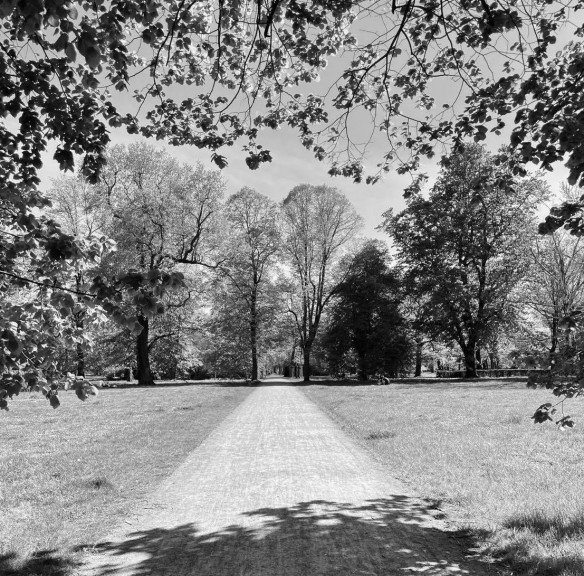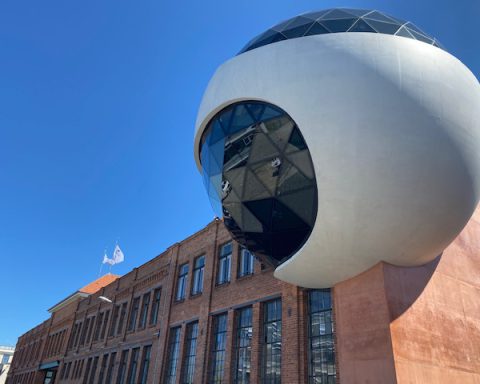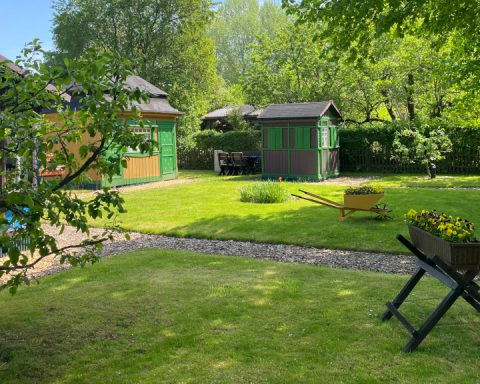The heavily gated entrance to Friedenspark in Leipzig fails to project the air of leisurely abandon its name intimates. Approaching the territory from the north, you have to pass through a triple gate—a set of iron double doors flanked to the left and right by two archways of yellow brick masonry. With the clandestine resignation of seasoned elders, they inspect blithe visitors. I walk up to the gate on a sweltry May afternoon, struck by the heavily sequestered feel of the terrain lurking behind. The geometric simplicity of the axial avenue, rimmed with rotund chestnut trees, lures me in. I only wish I knew nothing of its dark secrets.
For the past 50 years, the much-beloved Friedenspark has been hiding a skeleton in its closet.
Couples nonchalantly lolling about in the plush grass of the park on breezy summer evenings, and families sledding down the Rodelberg slope with snow crackling underneath their weight, are often unaware of what lies beneath. Merely a century ago, the cemetery graced a bourgeois quarter of the city, housing the remains of prominent Leipzigers. It is estimated that 140,000 individuals were buried here. Their remains entwined with the sinewy roots of aging trees, their tombstones swept under the lush cover of Rodelberg (aka Sledding Hill).
Little do the visitors know that the park’s main avenue once led to the cemetery chapel with its two morgues, or that the imposing entrance so unconventional for a space of leisure was rather representative of 19th-century cemeteries, symbolizing the journey to the afterlife.
The New Johannis Cemetery, as it was known in those days, came into being in 1846, following the realization that the Old Johannis Cemetery, the first state burial ground in Leipzig, was running out of capacity. Once the Old Cemetery ceased to admit below-ground residents in 1883, the New Cemetery came to shoulder the full burden. As a symbol of continuity, the cemetery was adorned with the former Johannis Hospital gate that once bordered the Old Cemetery, and by 1884, it was bedecked with carefully crafted memorials designed by Hugo Licht, a prominent Leipzig architect.
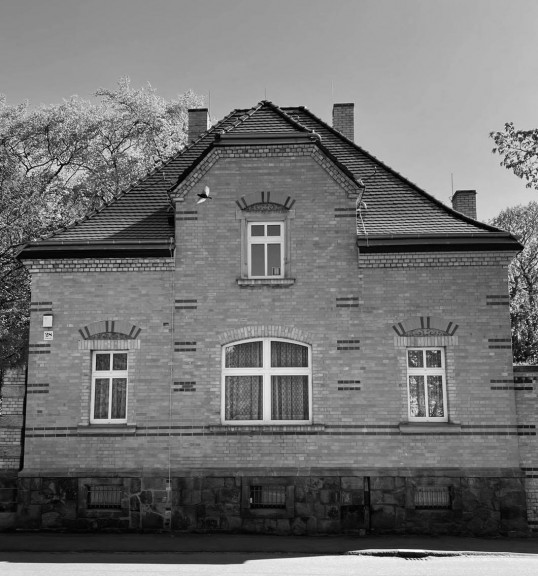
Regrettably, the Allied air raids during World War II razed most of the intricate tomb structures to the ground (“Parks und Gärten,” 28).
After the war, Leipzig was subjected to a series of urban renewal projects to facilitate the engineering of a new socialist personality.
The formerly lavish resting grounds of the bourgeoisie, sprawled out in the heart of the city, were a thorn in the side of the GDR aspirations for a classless society, not to mention the unsuitability of the cemetery’s acutely Christian profile amidst the state-sponsored Marxist atheism.
In the 1950s, the government’s resolve to substitute an outmoded past with a scientific future solidified into a plan to fashion a university quarter that would serve as the city’s focal point. This would require expanding the city’s celebrated university into the adjoining New Johannis Cemetery. As it became evident that none of the proposed projects would come to fruition, the university leadership approached the city’s mayor first with an offer to convert the New Johannis Cemetery into a plot for the Faculty of Agriculture and then, when that did not pan out, with a proposal to use the space for sports and recreation (Demshuk 2017, 35).
Perhaps with the remodeling in mind, the New Johannis Cemetery no longer accepted new burials from 1950 onward and was conclusively closed to the public in 1970.

The meager sources I could scout out about the former life of Friedenspark have one detail in common. The conversion of the cemetery into a park is invariably described as part of the “secularization” campaign initiated by the Socialist Unity Party of Germany. I ask myself: How do you secularize a cemetery? Is it enough to toss out crosses and whitewash biblical epitaphs from the headstones? Do you clip the wings of the marble angels guarding the graves? Do you coerce the dead into relinquishing their faith?
When a wave of state-led secularization swept over Leipzig in the 1960s, all sacred sites had to go.
First, the only remaining earmark of the Johannis Church—its 18th-century baroque tower—was blown up in 1963, and five years later, the architectural celebrity of the city, the Pauline Church, was hastily demolished in 1968 to mitigate counter-demonstrations (Demshuk 2017). Bulldozed were the bones of esteemed Leipzigers, entrapped with the rest of the debris, and transferred to a sandstone pit on the outskirts of the city.
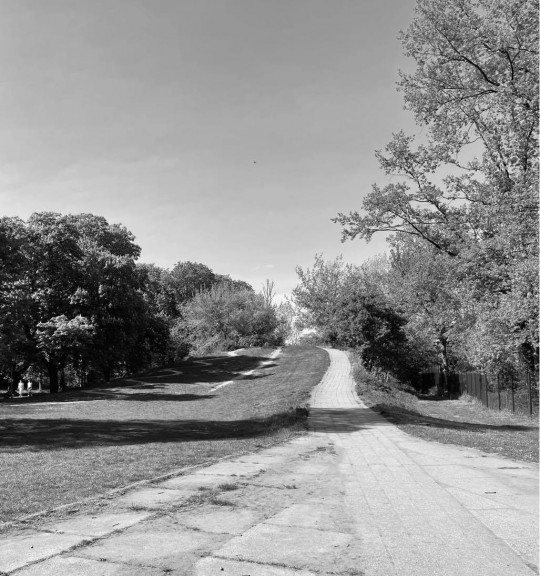
The ghastly spectacle and muted protests left the inhabitants relatively inured to the eradication of the New Johannis Cemetery between 1973 and 1975. Heavy machinery razed the graves and pressed the mashed rubble together to form today’s Rodelberg (Paul). In 1983, the revamped territory was presented to the public as Friedenspark, a travesty of those trapped underneath the unmarked land, unrecognized and unknown, for years to come.
Knowing that parts of the old wall, still carrying marks of the tombs, were left standing, alone and proud, on one edge of the park, I go searching.
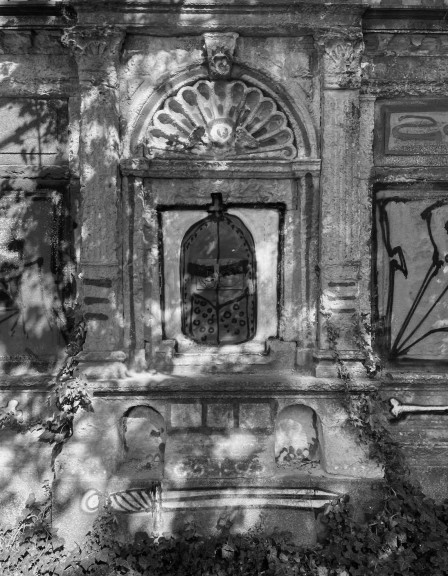
I cross a massive field studded with the nude tan bodies of sunbathing locals. Bicycles are strewn across like washed-up whales. I pass a playground to my right and a sports ground to my left. There I find it, beyond a row of strollers and solitary parents quietly observing their offspring from a distance: a dozen or so memorial walls, hardly discernible behind the overgrown shrubs and foliage. Walking along, I catch a glimpse of a cross. I brush wayward branches aside, paying no heed to the acrid stench of ammonia, and find myself face-to-face with two pudgy cherubs. Here they are, the above-ground ghosts of the cemetery, waiting to be regarded. I wonder if anyone else ever seeks them out.
Sources:
Demshuk, Andrew. 2017. Demolition on Karl Marx Square: Cultural Barbarism and the People’s State in 1968. Oxford: Oxford University Press.
Lapper, Jana. 2017. “Wer hier liegt, das weiß nur ich.” Taz. November 12. Accessed May 10, 2021. https://taz.de/Leipziger-Friedhoefe-in-der-DDR/!5458912/.
“Parks und Gärten: Im Grünen Leipzig.” Grüner Ring Leipzig: Pro Leipzig.
Paul, Alfred E. Otto. “Der Neue Johannisfriedhof zu Leipzig.” Leipzig Lese. Accessed May 9, 2021. https://www.leipzig-lese.de/index.php?article_id=283.

